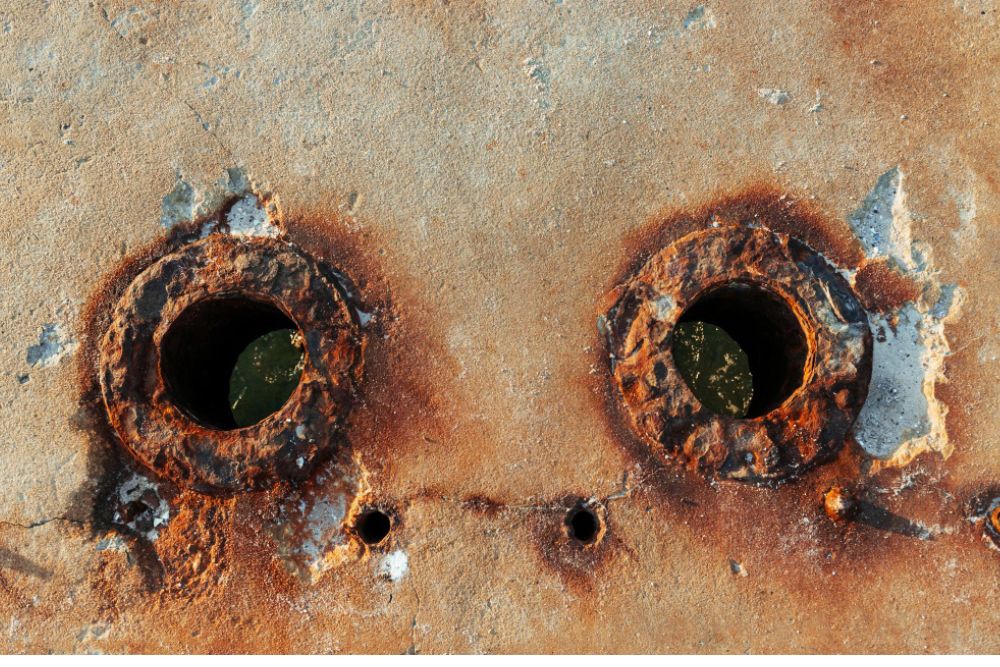Top Strategies to Avoid Crevice Corrosion – CORCON Institute’s Guide
Crevice corrosion is a challenging and often underestimated form of corrosion that occurs in confined spaces or narrow gaps, where the environment can become stagnant. Unlike general corrosion, crevice corrosion is highly localised, making it difficult to detect until significant damage has occurred. This type of corrosion is particularly problematic in industries where metal components are exposed to harsh environments, such as marine, chemical processing, and oil and gas sectors. Understanding the causes and preventive measures for crevice corrosion is crucial for maintaining the integrity and longevity of metal structures. At CORCON Institute of Corrosion (CIC), we are dedicated to promoting corrosion awareness and providing expert solutions to combat crevice corrosion and other corrosion-related issues.
Design to Minimise Crevices
When designing equipment or structures, it’s vital to minimise the presence of crevices. This can be achieved by avoiding sharp corners, overlapping surfaces, and tight joints where moisture and corrosive agents can become trapped. Proper design considerations can reduce the likelihood of crevice corrosion significantly. Additionally, ensuring that components fit together precisely and without gaps can further diminish the potential for crevice formation. Collaborating with design engineers who understand the risks of crevice corrosion is essential for creating durable and corrosion-resistant designs.
Use of Corrosion-Resistant Materials
Choosing materials that are resistant to corrosion is crucial in preventing this issue. Stainless steels with high levels of molybdenum, for example, offer better resistance to corrosion. It is essential to consult with corrosion experts, like those at CORCON Institute of Corrosion (CIC), to select the right materials for your specific application. In addition, consider the long-term environmental exposure of the materials and how they interact with other substances to avoid unexpected corrosion. Material selection should be based on a thorough analysis of the operating conditions to ensure maximum resistance to crevice corrosion.
Regular Inspection and Maintenance
Regular inspection of areas prone to crevice corrosion is essential for early detection and prevention. Maintenance schedules should include checks for crevices that might harbour corrosive agents. Timely intervention can prevent minor issues from escalating into severe crevice corrosion. Inspections should be conducted by qualified personnel familiar with crevice corrosion patterns and warning signs. Implementing advanced inspection techniques, such as non-destructive testing (NDT), can also aid in identifying hidden crevice corrosion before it causes significant damage.
Application of Protective Coatings
Applying protective coatings can be an effective measure to prevent crevice corrosion. These coatings act as a barrier between the metal surface and corrosive environments. CORCON Institute of Corrosion (CIC) recommends using coatings that are specifically designed to withstand the harsh conditions that can lead to crevice corrosion. It’s also important to ensure that the coating is applied correctly, with attention to detail in covering all potential crevice areas. Regular reapplication of protective coatings may be necessary, depending on the operating environment and the wear and tear on the coating over time.
Environmental Control
Controlling the environment in which metals are used can greatly reduce the risk of crevice corrosion. This includes managing factors like temperature, humidity, and exposure to corrosive chemicals. Environmental control measures should be tailored to the specific conditions of your operation to prevent the onset of crevice corrosion. Monitoring and adjusting environmental factors regularly can also help in maintaining an optimal environment that reduces the likelihood of crevice corrosion. Consider using dehumidifiers, temperature controls, and corrosion inhibitors as part of an integrated approach to environmental management.
Regular Cleaning and Debris Removal
Keeping surfaces clean and free from debris that can cause crevice corrosion is a simple yet effective preventive measure. Dirt, salt, and other contaminants can accumulate in crevices and accelerate corrosion. Regular cleaning routines can help maintain the integrity of metal surfaces. Using specialised cleaning agents that are designed to remove corrosive contaminants without damaging the protective layers is recommended. Additionally, establishing a cleaning protocol that targets hard-to-reach areas can ensure that even hidden crevices remain free from corrosive agents.
Frequently Asked Questions
What is crevice corrosion?
Crevice corrosion is a highly localized form of corrosion that occurs in confined spaces or narrow gaps, such as in joints, under gaskets, or in areas where metal surfaces are in close contact. It typically happens in areas where the environment becomes stagnant, leading to the accumulation of corrosive agents.
How does crevice corrosion differ from other types of corrosion?
Unlike general corrosion, which affects larger areas uniformly, crevice corrosion is confined to specific, often hidden, areas. It is more challenging to detect because it occurs in small, inaccessible crevices, making it more insidious and potentially more damaging.
What industries are most affected by crevice corrosion?
Crevice corrosion is particularly problematic in industries where metal components are exposed to harsh environments, such as the marine, chemical processing, and oil and gas sectors. These industries often deal with conditions that can lead to the formation of crevices and the subsequent onset of corrosion.
What materials are resistant to crevice corrosion?
Materials that are resistant to crevice corrosion include stainless steels with high levels of molybdenum, such as certain grades of duplex and super duplex stainless steels. These materials offer better protection against crevice corrosion due to their enhanced ability to withstand corrosive environments.
Closing Insights
By following these tips, industries can mitigate the risks associated with corrosion, ensuring the longevity and reliability of their equipment and structures. Proactive measures, such as regular inspections and the use of corrosion-resistant materials, play a crucial role in maintaining operational efficiency and safety. CORCON Institute of Corrosion (CIC) continues to lead in promoting corrosion awareness and providing expert guidance on preventing such issues globally, helping industries safeguard their investments and enhance their sustainability efforts.
Image Reference: Freepik
Disclaimer: All trademarks, logos, and brand names are the property of their respective owners. All company, product, and service names used in this website are for identification purposes only. Use of these names, trademarks, and brands does not imply endorsement.

